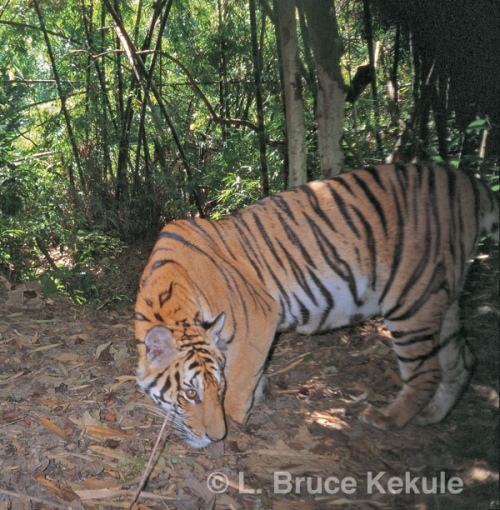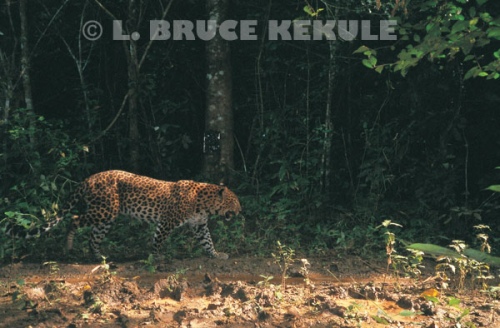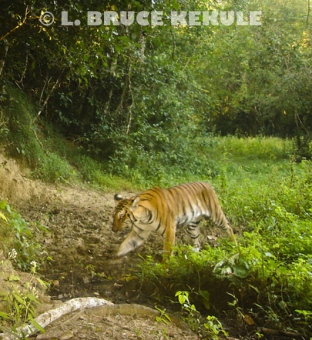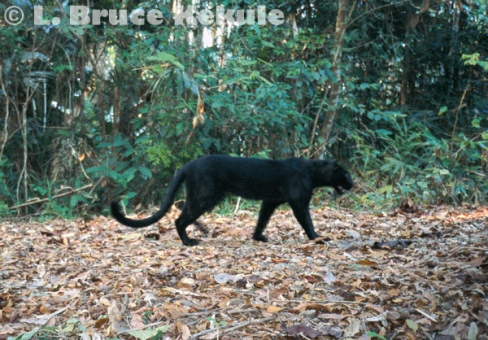Big Cats in Kaeng Krachan: The tiger and leopard
A look at tiger and leopard evolution in Asia
At the beginning of the dry season in January, the jungle canopy is still mostly green but falling leaves begin to carpet the forest floor as the first cold snap arrives. Some species of trees start their transformation, producing a mosaic of yellows, oranges, reds, browns and greens. For the first few hours each morning, heavy fog blocks out the sun as moisture dissipates from the forest. The Phetchaburi River is crystal clear as it flows through this magnificent forest.
Indochinese tiger camera trapped by the Phetchaburi River
A large predator walks the trails seeking its next meal. Sensing danger, a muntjac barks a warning. The whole community of wild animals is on alert as macaques and langurs cry out from the trees above. A striped carnivore stalks a herd of wild pigs. The nervous omnivores squeal and panic, running through the underbrush to escape. But the big cat is lightning quick – it catches a young pig with sharp claws. The struggle is over in seconds as fangs penetrate to the spine.
Leopard camera-trapped on an old logging road
The tiger has just made a kill. It lifts the lifeless prey into deep cover and devours the carcass. After feeding, the big cat seeks water for a thirst quenching drink. It will then lie down and rest until the desire to eat or drink begins again. Tigers will sometimes move great distances in search of food. But where there is an abundance of prey species, these magnificent cats continue to live in balance with nature. The average kill ratio for a tiger is about twenty unsuccessful attempts for one actual kill. At a certain time of year, the male tiger will seek out a female to carry on his legacy.
Another tiger by the Phetchaburi River
Kaeng Krachan National Park is a great wilderness that sits in the Tenassarim Range in southwest Thailand. It is one of the most beautiful protected areas left in the country. Elephants, gaur, tiger, leopard, tapir, gibbons, hornbills and literally thousands of other plants and animals still survive in a rich ecosystem that is world class.
A tiger camera trapped at a mineral lick in Kaeng Krachan
To understand how the tiger and leopard evolved, we must go back to the beginning of these wild creatures. After the carnivorous dinosaurs died out about 65 million years ago, mammals with sharp teeth, strong jaws and claws replaced them as the top land predators. The first successful mammalian carnivores were the Creodonts that evolved during the Eocene epoch 57-35 million years ago. Creodonts ranged in size from smaller than a weasel to as big as a bear. A bear-dog also evolved during this period. These carnivores all had voracious appetites that were satisfied by large concentrations of prey species, mainly the odd-toed and even-toed ungulates that browsed and grazed the lush forests and plains of the time. The early Creodonts evolved into the modern carnivores that we know today: the bears, cats, dogs and other predators.
Tiger camera trap abstract
The order Carnivora is separated into three superfamilies: The Arctoidea includes marten, weasel, badger, otter, bear and the panda; the Cynoidea are made up of the dog, fox and the wolf; and the Herpestoidea includes the mongoose, civet, hyena and the cat. Most carnivores are dedicated meat-eaters, but some groups such as civet, panda and bear are omnivorous, eating meat and plants.
Leopard camera trapped on a nature trail in the park
Nimravidae were the first cats to evolve in the Early Oligocene epoch, about 35 million years ago. They lasted till the Late Miocene, some eight million years ago, when huge grasslands had developed around the world. The large saber-toothed cats were the first of the family Felidae. These long-fanged felines evolved alongside huge herds of grazing mammals like antelope and cattle. There were several different species of saber-tooth, but they all became extinct about two to three million years ago.
Black leopard camera trapped on the main road in the park
Modern cats belong to the family Felidae and include: tiger, lion, leopard, jaguar, cougar and cheetah, and all the smaller cats such as lynx, bobcat, jungle cat, fishing cat to name just a few plus domestic cats. Wild carnivores feed almost exclusively on vertebrate prey and sit at the top of the food chain. Tiger and lion have few predators apart from man but a pack of wild dogs however are a constant threat to the large cats and their offspring. The tiger and leopard belong to the genus Panthera, or roaring cats, that include the lion and the jaguar.
Leopard camera trapped in the interior
Thousands of years ago when primitive humans lived off the land as hunters and gatherers, they survived by pure instinct. They killed animals for meat and skins, and also gathered many different tools and plants from the forests. As humans became more sophisticated, they used weapons to take down larger animals. Clubs, spears, knives, bow and arrows were all that separated them from almost certain death at the claws and jaws of a predator many times their size.
Black leopard camera trapped on an old logging road
The possibility of being eaten by a carnivore like a tiger or leopard must have been on everyone’s mind that lived in or near the wilderness. Entering the forest where every step could be the last was like walking a tightrope. Attack normally lasted only seconds as a huge predator pounced from behind, biting the neck and causing almost instant death. Very few people survive such an incident. It must have been a scary environment to live in.
The will to survive, however, was strong and men eventually conquered his fear of the wild cats with more modern weaponry. The tables had finally turned and the predators became the hunted. As human populations and settlements grew, the forests were quickly transformed into agricultural land.
An Indochinese tiger on the prowl at night by the Phetchaburi River
After firearms were invented, European royalty, native kings, landlords, planters, foresters, government officials and many adventurers journeyed to the forests of Asia in search of the tiger. Mostly, they came to prove their dominance over the big cat. A trophy of tiger on the wall or floor at home proved beyond doubt that the owner was the supreme species. One could boast of their prowess as a hunter.
But the fact is most hunters shot tigers and leopards from the safety of a tree-blind, vehicle or elephant back. The cats would be attracted to within gun range by cattle, buffalo or a goat used as bait. For special hunts, hundreds of local villagers were recruited as beaters, trackers and mahouts. To join a shikar (Indian word for the hunt) was the ultimate experience for the adventurous.
The same tiger as above a few moments later
More tigers have been killed for sport in India then anywhere else in the world. In the days of the Raj, it was common to see five, ten or twenty cats lying dead on the ground in front of a hunting party. The Maharajah of Surguja killed some 1,157 tigers during his reign. Some Englishmen claimed to have shot more than 100 tigers. Fortunately in 1972, the Indian government finally banned hunting because the tiger and many other species were threatened with extinction.
The most famous hunter ever to overcome his fear of the big Asian cats was Jim Corbett of India. From 1907 to 1939, he single-handedly dispatched scores of man-eating tigers and leopards. His book ‘Man-eaters of Kumaon’ is a classic. Some cats mentioned in the book had killed hundreds of people. Corbett National Park was established in his honor, and the Indo-Chinese subspecies of tiger Panthera tigris corbetti is named after him.
In Thailand, the tiger and the leopard were also hunted for sport but on a much smaller scale than in India. In the past, rural Thai people living near wilderness areas built houses high off the ground that protected them during the night. But daytime was another thing. If they worked in fields bordering thick jungle or they went into the forest, they risked their lives.
At the turn of the 20th Century as modern firearms, agriculture and transportation took hold in the Kingdom, the forests and wildlife began to disappear. Man-eaters also declined. However, during World War II along the death railway in the Sai Yok district of Kanchanaburi province there were still accounts of man-eating cats. In recent times, there has been no such record. From time to time, domestic cattle are still killed by a tiger or leopard but this is now very rare. Low wildlife densities in the forest and easy prey are the main reason for this occurrence.
Thailand is fortunate in that tiger and leopard plus another seven species of cat still survive in some of the larger national parks and wildlife sanctuaries. Kaeng Krachan National Park is one of those protected areas that still harbor the big cats. Tigers can and do kill the leopard. Although their paths do cross, normally the spotted cat will avoid the striped predator. Documentary accounts and photographs do exist of tigers eating leopards.
In 2002-2003 while carrying out camera trap work in Kaeng Krachan in cooperation with the National Parks, Wildlife and Plant Conservation Department, I was surprised and elated to see both species tripping the same cameras in several areas only days apart. In one month, four different leopards, one of them black, were caught on film. In the following month, a leopard was caught during the day, and a huge male tiger stopped and posed for the camera. Both species were using the same trail for their hunting forays. A few other protected areas like Huai Kha Khaeng and Thung Yai Naresuan wildlife sanctuaries have records of overlapping.
In Kaeng Krachan, an important discovery is that tiger and leopard hunt at all times during the day. It is usually thought they are only active in the late afternoon and throughout the night preferring to rest during the day. More research is required if we are to determine the pattern of daytime hunting by the big cats here. It is probably due to the pristine state of this forest and the lack of human activity.
Without doubt, the future of the big cats depends on one thing only – the complete protection of the remaining forests where they live. If the national parks and wildlife sanctuaries remain intact with a high number of prey species, the big cats will survive. But if overdevelopment and encroachment is allowed to continue, these magnificent animals will eventually disappear.
Unfortunately, too much time and money is wasted by too many organizations talking about saving the tiger and other wildlife, with very little actually being done. Human population growth will eventually destroy most wild places. Only true protection by a few dedicated people will slow the destruction of nature’s precious wildlife and wilderness areas. It is only hoped that the tiger and leopard will continue to survive as they have for millions of years.
Leopard – Panthera pardus
The leopard is closely related to the jaguar of South America. Both have a spotted coat pattern, incidence of melanism (black phase), and relatively short legs. The present distribution of the leopard is restricted to Asia Minor, India, Southeast Asia, the Himalayas, Tibet, China, Siberia, and Africa. Fossils of leopards were found in Pleistocene deposits throughout Europe, the Middle East, Java, and Africa, some 1.5 million years old. These secretive cats are mainly nocturnal. Their populations and ranges are difficult to determine but radio tracking of collared animals has shed new light on their movements and area they live in. ‘Spots’ is more tolerable to humans and their settlements.
Tiger – Panthera tigris
According to fossil evidence Panthera cats branched from the other Felidae about five million years ago in Asia. The first tigers originated in eastern China. Fossils of the earliest tigers date back to the Pleistocene epoch, about 1.6 to two million years ago, have been found in Henan, southeast China, and on the island of Java in Indonesia. The historic range of the tiger covered much of Asia and some of its islands.
However, humans have had an enormous impact on the geographic range of the species. The big cat only survives in 13 countries: Russia, China, India, Nepal, Bhutan, Bangladesh, Burma, Laos, Cambodia, Vietnam, Indonesia, Malaysia and Thailand. The present range is less than five percent of the tiger’s former range. There are less than 5,000 tigers left in the wild.












